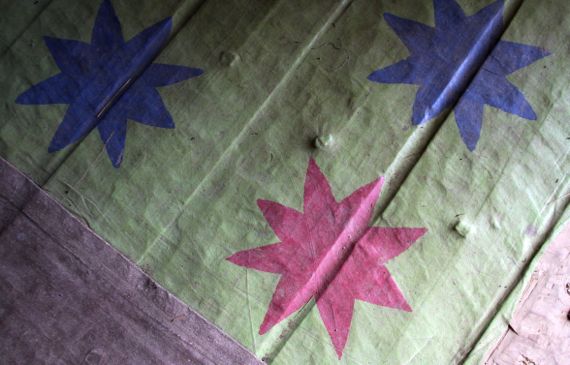
The image is oilcloth, or what passes for oilcloth. Funny stuff, oilcloth. The oil in oilcloth traditionally was linseed, that is oil from flax (Linum usitatissimum) seeds. Flax has a long history, and has been used for both fiber and seed-oil. Linseed oil has an usual property: over time, it sets up. So, for example, to make window glazing, it was mixed with chalk dust (hence the white glazing in old photos and paintings).
In “the old days,” oilcloth, although heavy and stiff, was a good choice for waterproofed applications. Waxed fabrics were another option. The later rubberized fabrics were a huge breakthrough.
No connection I can come up with between oilcloth and an unexpected thing I learned about today: the Vasari corridor. It’s a hobbit-trail/enclosed passageway dating to post-Medieval Florence…uhem…Firenze.
It connects the Palazzo Pitti with the Uffizi and Palazzo Vecchio. It crosses the Arno above the shops along the Ponte Vecchio, and passes through the upper reaches of a church, and above many homes. This is how the wealthy in pre-limo days commuted from home to office. In this case, the commuter was Grand Duke of Tuscany, Cosimo I de’ Medici (1519–1574). He lived on the south side of the Arno, in the gigantic Palazzo Pitti, and worked, or at least presided over, events in the Uffizi (offices), on the north side of the river. The corridor…just made his work-day easier.
The corridor was designed by Giorgio Vasari and built in five months in 1564. Today, access is nearly always closed, although along the walls of the almost 1 km long enclosed hallway are over 1000 paintings/works of art—the Uffizi’s self-portrait collection, which continues to receive new additions. There’s a second corridor off the north side of the Uffizi, with access to the Palazzo Vecchio. Thus, if you had the chops, you could move easily between the decision-making centers of Florence, and the stinky populace would have no idea you were strolling above.
The High Line is about a mile long, is in NYC, and the earliest section opened in 2009. It’s public, not private, and open to the skies, and thus quite different from the Medici pathway. They both have art, though.